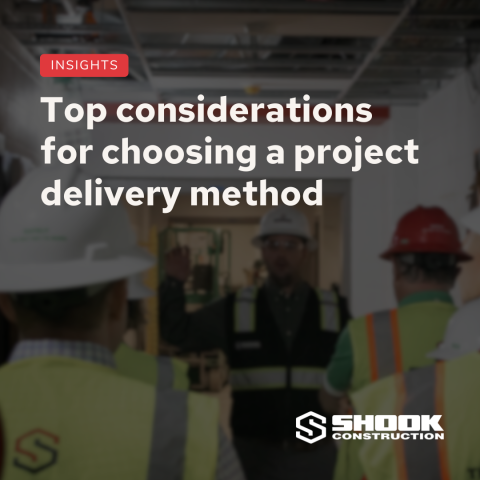
June 5, 2024 Insights
Top Considerations for Choosing a Project Delivery Method

Is your organization ready to tackle an upcoming project? Congratulations! It takes a lot of work to get to the point where you are ready to engage a design and construction team. As you look to move that project forward, you have another decision to make: which delivery system will you choose for this project? From traditional Design-Bid-Build methodology to more collaborative methods such as Construction Manager at Risk and Design-Build, each method has unique factors that can benefit a project.
With 98 years of construction expertise, Shook has experience working with each of these delivery methods for projects both big and small. Our team identified the key internal and external factors to consider that will help guide you to the most appropriate delivery system for your project. Let’s get started!


WHAT ARE THE MAJOR DELIVERY METHODS?
-
Design-Bid-Build: Under Design-Bid-Build or “Hard Bid,” an owner contracts with a design team (usually, but not always, led by the architect) to develop drawings and specifications into bid documents. These documents are then bid to a selection of General Contractors that meet minimum bondability requirements. The lowest cost bid is then selected.
-
Construction Manager at Risk (CMR): The owner contracts with a pre-qualified CM at Risk during the preconstruction/planning/programming stage, usually shortly after (and occasionally at the same time as) they contract separately with a design team. This allows the owner and designer to receive real-time input on pricing, constructability, and value engineering (cost reduction) alternatives as the design is being developed.
- Design-Build: This delivery system is similar to CMR in that the builder and designer are collaborating during preconstruction. However, the contractual relationships are streamlined, with the owner having a single contract with the Design-Builder. The Design-Build Contractor in this environment would contract separately with the architect/engineering team.
WHAT FACTORS SHOULD BE CONSIDERED WHILE CHOOSING A DELIVERY METHOD?
Each of the following factors that play a major role in choosing a delivery method:
Is this a straightforward, uncomplicated project? If so, a standard design-bid-build delivery system will likely meet the needs of the project. A good example of this would be salt domes for transportation departments. Here, there is rarely much variation beyond the size of the desired structure and building material requirements.
The obvious answer for most owners is—of course it is! But is that really true? When probing to the root cause, the answer is—it depends. For an operating hospital, school or manufacturing facility, an aggressive schedule for an interior renovation or expansion will often be critical to minimize disruption to ongoing activities (and for industry, profitability). In this case, CMR or Design-Build can take advantage of overlapping design and construction activities to reduce the overall project delivery schedule. For example, as the CM or Design-Builder is brought on in the preconstruction process, the firm can move forward with bidding early site and foundation projects while the more complicated and intricate interior MEP and finish details are still early in design. This is simply not possible under a hard bid model, which has a very ridged, linear design-bid-build dynamic.
This is often a key consideration for public clients such as school boards and superintendents, where accurate and timely cost information is essential before going to the taxpayer for a levy to help finance a project. Although designers can and do furnish this information, the data is often second-hand or out of date which can be detrimental to the success of a project. Involving a Construction Manager or Design-Build contractor early in the preconstruction process can significantly benefit the project. After all, who better to provide the most up-to-date information on building costs other than the entity that deals with it every day?
This is often referred to as a Guaranteed Maximum Price (GMP) and needs a little explanation. Under a hard bid/design-bid-build environment, competing general contractors will give you their lowest, guaranteed price based on the drawings and specifications given to them.
Why the italics? Because the price received is based strictly on what the drawings and specs from your designer show. If anything is missing, the GC is motivated NOT to include it in the price (if they want the job). Post-award, the owner can often find themselves seeing those missing items put back in the form of expensive Change Orders. The owner must then either authorize the extra costs or have the general contractor and designer battle it out whether the CO should or should not exist based on the “design intent.” That leaves the owner in the uncomfortable position of referee.
Conversely, under a CMR or Design-Build delivery, the contractor and designer work together through preconstruction/design so the contractor can “fill in the blanks” in the drawing package and do a thorough scope review prior to bidding. If anything is missing but is intended to be there (i.e. design intent), the contractor is responsible to the owner to absorb those extra costs.
There is a common misconception among some building owners (and designers) that Value Engineering means cutting the scope (reducing square footage) of a project when it is trending to be over budget in design. In practice, a good CMR or Design-Builder will look for ways to collaborate with owners and architects to identify cost reduction opportunities without reducing the size of the building, important aesthetic considerations, or quality of materials.
In all cases, potential cost savings ideas should be presented to the owner for acceptance or rejection. Below is an example of accepted VE ideas from a recent Shook Construction school project, totaling over $3 million.
Exterior
» Fiber cement panels replaced with concealed fastener metal panels
» Metal panel in lieu of curtainwall/spandrel/lattice combination
» Chain link fence instead of masonry enclosure at little-seen dumpster
Interior
» ACT-2 ceiling tile in lieu of WD/Linear Metal ceiling in dining room
» Reduce number of operable partitions
» Allow copper ProPress in lieu of copper solder
So, to answer the question, projects that would benefit the most from VE are larger, more complex construction projects that offer several different materials, means, and methods to achieve a similar end product.
Many owners want to have significant control over the entire design, construction, and commissioning process. For larger, well-staffed facility departments, a traditional design-bid-build process might be ideal. However, in today’s business environment, which puts a priority on doing more with less (staff), this might not be an option. This is where a Construction Manager or Design-Builders can help. With collaborative delivery models, the CM acts as your representative throughout the lifecycle of the project—not just by building the project, but by also making sure your design, schedule, and quality goals are met.
YOU’VE IDENTIFIED THE KEY CONSIDERATIONS FOR YOUR PROJECT. WHAT'S NEXT?
Now that you’ve explored the various internal and external factors to consider in choosing the ideal project delivery system, it’s time to put it all together. Which delivery method is best for your project? After providing a yes or no answer to each of the questions in the image below, simply total up the amount of “Yes” votes for each column to determine if a traditional method or collaborative method would be best. Whichever column tallies up the most “Yes” selections should point you in the right direction in choosing the proper delivery method for your project.
If you still have questions on delivery systems or want to discuss the intricacies of your project in more detail, Shook’s team of experts are here to help! Email us at info@shookconstruction.com to let us know how we can help and a Shook representative will be in touch soon.
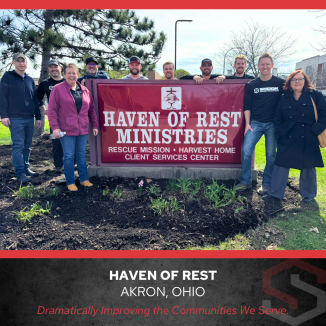 Volunteering at Haven of Rest
April 11, 2025Mission
Volunteering at Haven of Rest
April 11, 2025Mission
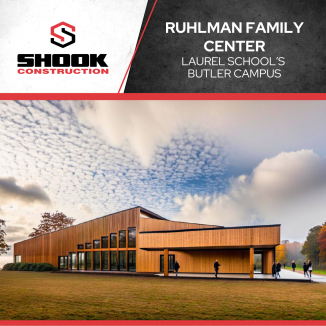 Activities are Picking up on the Ruhlman Family Center Project
April 10, 2025News
Activities are Picking up on the Ruhlman Family Center Project
April 10, 2025News
 Ryan Levesque Named Triangle Business Journal 40 Under 40 Winner
April 8, 2025Awards
Ryan Levesque Named Triangle Business Journal 40 Under 40 Winner
April 8, 2025Awards
 The Mid-Atlantic Picnic Was a Hit
April 4, 2025News
The Mid-Atlantic Picnic Was a Hit
April 4, 2025News
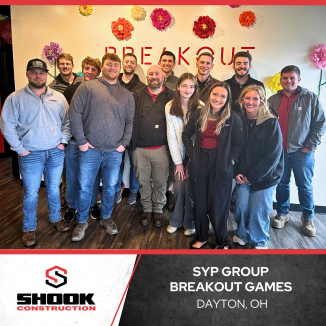 Shook Young Professionals Breakout!
March 28, 2025News
Shook Young Professionals Breakout!
March 28, 2025News
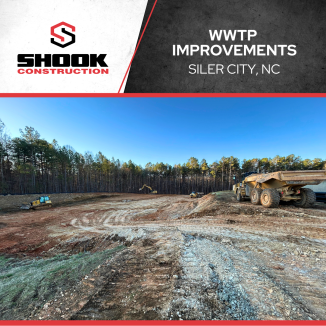 WWTP Improvements Siler City, NC
March 27, 2025News
WWTP Improvements Siler City, NC
March 27, 2025News
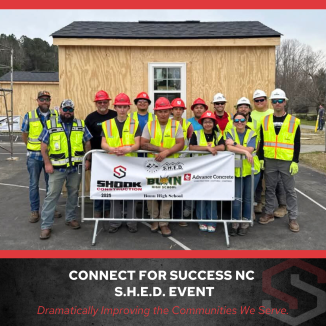 Sponsoring Connect for Success' S.H.E.D. Event
March 26, 2025Mission
Sponsoring Connect for Success' S.H.E.D. Event
March 26, 2025Mission
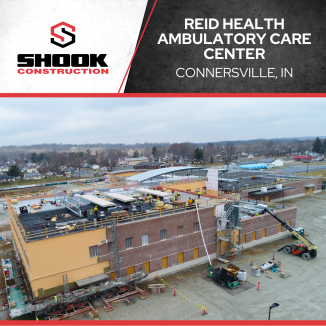 Reid Health's New Ambulatory Care Center is Taking Shape!
March 25, 2025News
Reid Health's New Ambulatory Care Center is Taking Shape!
March 25, 2025News
 Equipment Center Installs Community Cupboards in Harrison Township
March 21, 2025Mission
Equipment Center Installs Community Cupboards in Harrison Township
March 21, 2025Mission
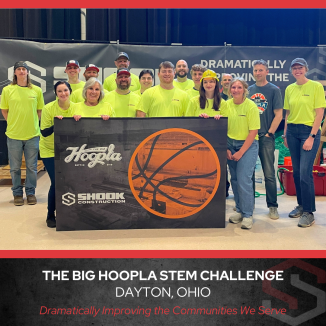 Providing Hands-On Construction Experience at The Big Hoopla STEM Challenge
March 20, 2025Mission
Providing Hands-On Construction Experience at The Big Hoopla STEM Challenge
March 20, 2025Mission
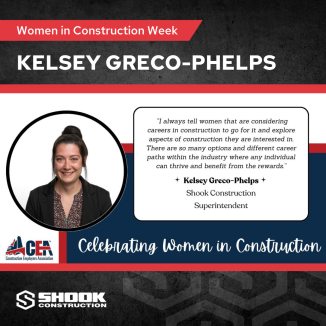 Women in Construction: Kelsey Greco-Phelps
March 19, 2025News
Women in Construction: Kelsey Greco-Phelps
March 19, 2025News
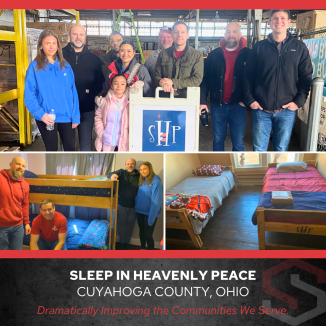 Sleep in Heavenly Peace Delivery Event
March 19, 2025Mission
Sleep in Heavenly Peace Delivery Event
March 19, 2025Mission
